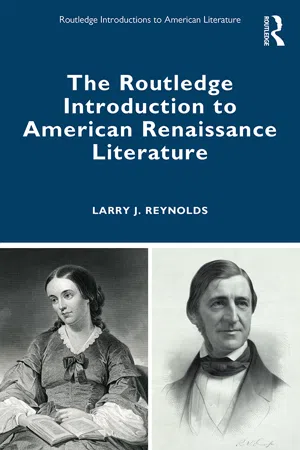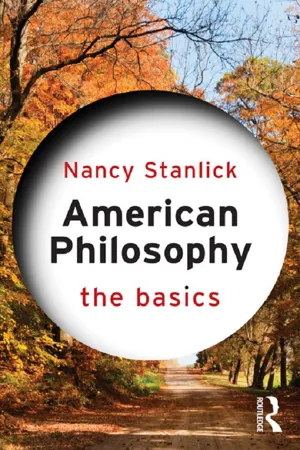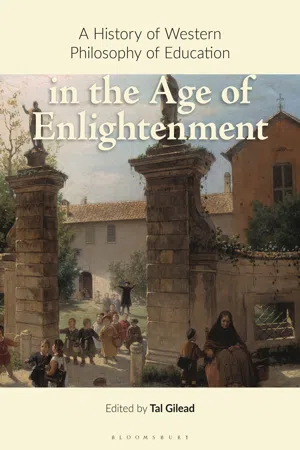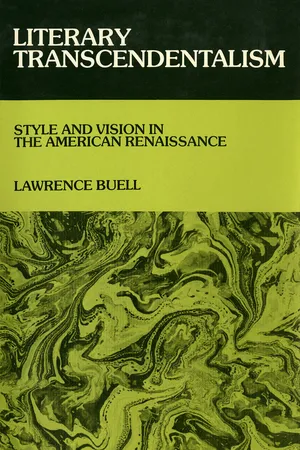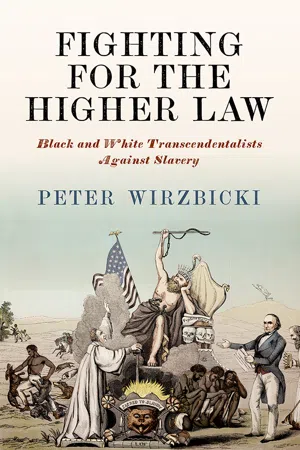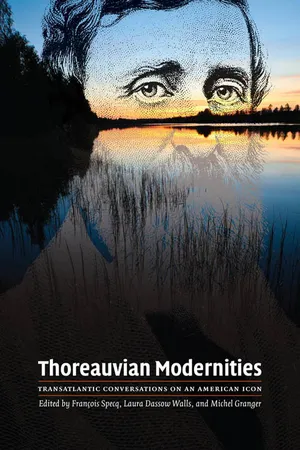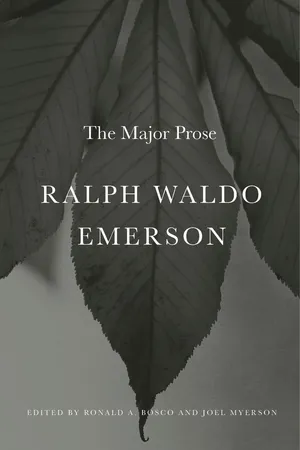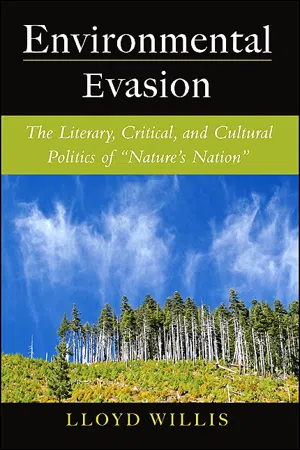Literature
Transcendentalism
Transcendentalism was a philosophical and literary movement in the 19th century that emphasized the inherent goodness of people and nature, as well as the importance of self-reliance and individual intuition. It rejected traditional religious and societal norms, advocating for a spiritual connection with the natural world and the pursuit of personal truth. Key figures associated with Transcendentalism include Ralph Waldo Emerson and Henry David Thoreau.
Written by Perlego with AI-assistance
Related key terms
10 Key excerpts on "Transcendentalism"
- Larry J. Reynolds(Author)
- 2021(Publication Date)
- Routledge(Publisher)
2 Emerson, Thoreau, and Transcendentalism DOI: 10.4324/9781315751627-2 In New England in the late 1830s, a group of intellectuals later known as Transcendentalists came together to discuss new ideas about religion and philosophy. They included Unitarian ministers, young poets, teachers, and thoughtful men and women of various sorts. The writings of three members of this group have made major contributions to the American Renaissance and United States cultural history: Ralph Waldo Emerson (1802–1882), Henry David Thoreau (1817–1862), and Margaret Fuller (1810–1850). Although their writings differed widely, each participated not only in the Transcendentalist movement, but also major reform movements, including abolitionism and women’s rights. This chapter will focus primarily on Emerson and Thoreau, while the next will feature Fuller. To many of their contemporaries, the Transcendentalists seemed misguided and practically incoherent. Emerson, in an essay of his titled “The Transcendentalist,” defined Transcendentalism as “Idealism as it appears in 1842” (Essays & Lectures 193). He first offered this definition to an audience in Boston in January 1842, as he tried to explain the “new views” that had recently appeared in New England. The term “transcend” means literally “to go beyond,” and what this meant for Emerson and a number of his friends was to rise above the material world filled with illusions and achieve union with spiritual reality, in short, with the divine. There is a strong mystical strain in Emerson and in Thoreau as well, and both were often viewed as pantheists, that is, persons who believe that all of creation contains sparks of the divine, including rivers, rocks, and trees, not to mention people and animals- eBook - ePub
- Nancy Stanlick(Author)
- 2012(Publication Date)
- Routledge(Publisher)
NEW ENGLAND Transcendentalism AND THE CONTINUING SPIRIT OF REFORMThe primary spokesmen for New England Transcendentalism are Ralph Waldo Emerson (1803–82) and Henry David Thoreau (1817–62). Their philosophy is in part a variation on Kantian metaphysics and epistemology and it is meant to transform Americans and American culture. Much like the revolutionary women and Abolitionists who were their contemporaries, the New England Transcendentalists speculated and wrote about issues and events having significant effects on moral, social, and political life. In “Resistance to Civil Government” (1849), Thoreau directly addressed the injustice of the Mexican-American War and the atrocious treatment of runaway slaves in a country ironically priding itself for championing liberty, equality, and dignity for all. Thoreau offered a means to combat injustices that he thought would cut them off at their base if only more people would speak and act against them. The Transcendentalists expected those who theorized about the independence, freedom, fairness, uniqueness, and power of America to put their words into practice.Emerson and Thoreau encouraged Americans to become uniquely American not only in principle but also in fact and deed. Whether it is Emerson extolling the virtues of virile action to become uniquely American or Thoreau living a deliberate and solitary life at Walden Pond, the message is the same: to realize in oneself and in one’s society the capacity for unique self-creation to transform social and political life to fit the dignity and value of the human being.That one must become truly and uniquely oneself and that Americans must become truly and uniquely American find expression in Emerson’s “Self-Reliance” (1841) and “The American Scholar” (1837). Further, the requirement of each person not to be spineless and cowardly is in Thoreau’s Walden - Tal Gilead, Tal Gilead(Authors)
- 2021(Publication Date)
- Bloomsbury Academic(Publisher)
education in service of human transformation. I explore different vistas of education the transcendentalists open up for us and show the radicalism of their philosophical orientation. American Transcendentalism is not of interest primarily for historical reasons because, in important respects, these writers were ahead of their times. Their work retains a powerful significance for various issues in contemporary education—above all, moral education, citizenship and political education, and education in language. They teach us how significant it is to achieve transcendence in the ordinary today. This is especially significant given global trends of education that are so dominated by measurement and transparency.HISTORICAL BACKGROUNDThe American Transcendentalism of New England was an intellectual movement whose heyday was between the mid-1830s and the mid-1840s. It was, to use the contemporary fashionable term, “interdisciplinary” in that it incorporated literature, poetry, art, religion, philosophy, and social thought. It was also cross-cultural (or international) in that it brought together not only anglophone traditions but also German thought and Asian classics deriving from Hindu, Buddhist, Confucian, and Islamic culture (Buell 2006: xiii). The major figures who carried this movement include Ralph Waldo Emerson (1803–82), Henry David Thoreau (1817–62), Margaret Fuller (1810–50), Amos Bronson Alcott (1799–1888), George Ripley (1802–80), Orestes Brownson (1803–76), Elizabeth Peabody (1804–94), and Frederic Henry Hedge (1805–90). They called for social reforms as well as the intellectual regeneration of American culture. It should be noted, however, that, as Lawrence Buell has pointed out, there were “disagreements among Transcendentalists as to the relative importance of the elevation of single individuals versus the elevation of society as a whole” (2006: xxiv): Emerson and Thoreau in the former group, George Ripley, in the latter. Buell points out that there was a “shift in thinking among a number of Transcendentalists as the 1840s unfolded, from an early individual-centeredness to a keener social conscience and attentiveness to hard political realities” (p. 252).- eBook - ePub
Literary Transcendentalism
Style and Vision in the American Renaissance
- Lawrence Buell(Author)
- 2016(Publication Date)
- Cornell University Press(Publisher)
Small wonder, then, that at one time or another studies of every major Transcendentalist have tried to disassociate their hero from the charge of Transcendentalism. 4 Nevertheless, the term does have an accepted core of meaning, which can be stated briefly and I think uncontroversially. Further ramifications are possible, and some will be introduced below, but for the moment a short working definition should suffice. Historically, New England Transcendentalism can be viewed as one of many instances of the widespread religious ferment which took place in America during the first half of the nineteenth century. 5 As a self-conscious movement, Transcendentalism served as an expression of radical discontent within American Unitarianism (which, in turn, was a liberal movement within Congregationalism), arising from objections to Unitarian epistemology and the Lockean psychology upon which it was based. Locke held that all human knowledge is derived empirically, through the experience of the senses; the Unitarians, accepting this as a premise, held that God and his laws are apprehended by rational reflection on the natural creation and the revelations of scripture, rather than by direct intuition. 6 To the young Unitarian radicals of the 1820s and 1830s, however, this position was oppressive, for it seemed to cut man off from God. Stimulated by post-Kantian thought, as interpreted chiefly by Goethe, Carlyle, and especially Coleridge, they began about 1830 to contend, with the aid of a distinction adapted from Coleridge, that in addition to his “understanding” or capacity for empirical reasoning man has a higher mental faculty, or “Reason,” which enables him to perceive spiritual truth in tuitively. 7 The Unitarians’ idea of reason/understanding (they used the two terms interchangeably) was actually more liberal than their critics realized; as we shall see in Chapter 1, Unitarianism can be said to have paved the way for the radicals’ position - eBook - ePub
- Susan Castillo(Author)
- 2010(Publication Date)
- Wiley-Blackwell(Publisher)
A major current of thought in Jacksonian America was Transcendentalism. In a way, much Transcendental thought reflects the Puritan conundrum about how the individual comes to apprehend truth and reality: whether it was revealed directly to the human heart (as in Anne Hutchinson’s antinomian theology, discussed in Chapter 3), or whether it can be discerned through the sensory perception of ordinary experience. The prose produced by Transcendentalist writers reflects this ambivalence; indeed, the more literal-minded might be forgiven for reacting with despair on attempting to distill from the clouds and mist of Transcendental prose what exactly the group stood for. Nathaniel Hawthorne depicts this confusion admirably in his short story “The Celestial Railroad” (1843), in which he recasts Bunyan’s Pilgrim’s Progress as a journey on an allegorical railroad to heaven in the rapidly industrializing America of the nineteenth century: At the end of the valley, as John Bunyan mentions, is a cavern, where, in his days, dwelt two cruel giants, Pope and Pagan, who had strown the ground about their residence with the bones of slaughtered pilgrims. These vile old troglodytes are no longer there; but into their deserted cave another terrible giant has thrust himself, and makes it his business to seize upon honest travellers and fatten them for his table with plentiful meals of smoke, mist, moonshine, raw potatoes, and sawdust. Referring to the origins of Transcendental thought, Hawthorne adds, He is a German by birth, and is called Giant Transcendentalist; but as to his form, his features, his substance, and his nature generally, it is the chief peculiarity of this huge miscreant that neither he for himself, nor anybody for him, has ever been able to describe them. As we rushed by the cavern’s mouth we caught a hasty glimpse of him, looking somewhat like an ill-proportioned figure, but considerably more like a heap of fog and duskiness - eBook - ePub
Fighting for the Higher Law
Black and White Transcendentalists Against Slavery
- Peter Wirzbicki(Author)
- 2021(Publication Date)
- University of Pennsylvania Press(Publisher)
Freedom occurred, the Transcendentalists thought, in the fertile mix of the given and the willed, the dialogue between a physical reality that shapes us and our consciousness that is free to shape itself. As Emerson wrote, good thinking lay between abstract consciousness—“the thin and cold realm of pure geometry”—and raw “sensation.” He called this “the equator of life, of thought, of spirit, of poetry.” 135 Fuller agreed: a consciousness who “remains imbedded in nature” would never understand the meaning of life, but nor would one who was so self-absorbed that they ignored the beauty and divinity that nature reveals. 136 While they always emphasized the importance of the higher parts of consciousness to compensate for society’s dismissal of it, they still demanded a dialogue with the empirical world, a constant to and fro between these components of the self, an embrace of thinking as the two-in-one of a consciousness that was both observer and observed. 137 Through this doubleness, they thus avoided both the narrowness of a mechanical psychology and the self-indulgence of an idealism that would never realize itself in concrete action. Thoreau immersed himself in the sounds, sights, and animal life of Walden Pond. Emerson embraced the whims of his subconscious, the hidden wisdom found in the dark “chambers and magazines of the soul.” 138 Whitman sang of the dusty open road, the joyful solidarity of mingling with rowdy crowds and haughty citizens of the street. To think freely, then, for Transcendentalists required one to experience the world in all its bright and complex glory and then reflect on what one has learned, to open up a dialogue between the experiencing-self and the reflecting-self - eBook - ePub
Thoreauvian Modernities
Transatlantic Conversations on an American Icon
- François Specq, Laura Walls, Michel Granger(Authors)
- 2013(Publication Date)
- University of Georgia Press(Publisher)
I begin with a double historical claim: first, that there was an ontological turn in American thought in the early to mid-nineteenth century; second, that the Transcendentalist movement was part of this turn and furthermore saw itself as such. These are not claims I make lightly. The evidence for them is quite simply overwhelming.But before I turn to specifics, a brief acknowledgment is in order. What I call the ontological turn, as applied to writers like Thoreau, Emerson, and their peers, is a variation on what Herbert Schneider once called, in a brilliant aperçu left largely undeveloped, Transcendentalism’s “escape from phenomenology.” I would like to shift Schneider’s emphasis and present the movement in more positive terms—less as an escape from than as a search for —a quest for what Thoreau called in Walden a “solid bottom” (330), a quest for metaphysical foundations. Thoreau’s was an age much preoccupied, not to say obsessed, with “permanence” and the grounds of being, selfhood and religious faith. In their metaphysics, the Transcendentalists may be described as realists—that is to say, they embraced metaphysical realism, which, to borrow Roy Bhaskar’s useful definition, supposes “an ontology , as distinct from epistemology.” The distinction is crucial, if we would avoid the “epistemic fallacy”—an exclusively epistemological definition of being, or the belief that “ontological questions can always be reparsed in epistemological form: that is, that statements about being can always be analysed in terms of statements about our knowledge (of being)” (Reclaiming - eBook - ePub
- Ralph Waldo Emerson, Ronald A. Bosco, Joel Myerson(Authors)
- 2015(Publication Date)
- Belknap Press(Publisher)
The Transcendentalist 1 The first thing we have to say respecting what are called new views here in New England, at the present time, is, that they are not new, but the very oldest of thoughts cast into the mould of these new times. The light is always identical in its composition, but it falls on a great variety of objects, and by so falling is first revealed to us, not in its own form, for it is formless, but in theirs; in like manner, thought only appears in the objects it classifies. What is popularly called Transcendentalism among us, is Idealism; Idealism as it appears in 1842. As thinkers, mankind have ever divided into two sects, Materialists and Idealists; the first class founding on experience, the second on consciousness; the first class beginning to think from the data of the senses, the second class perceive that the senses are not final, and say, the senses give us representations of things, but what are the things themselves, they cannot tell. The materialist insists on facts, on history, on the force of circumstances, and the animal wants of man; the idealist on the power of Thought and of Will, on inspiration, on miracle, on individual culture. These two modes of thinking are both natural, but the idealist contends that his way of thinking is in higher nature. He concedes all that the other affirms, admits the impressions of sense, admits their coherency, their use and beauty, and then asks the materialist for his grounds of assurance that things are as his senses represent them. But I, he says, affirm facts not affected by the illusions of sense, facts which are of the same nature as the faculty which reports them, and not liable to doubt; facts which in their first appearance to us assume a native superiority to material facts, degrading these into a language by which the first are to be spoken; facts which it only needs a retirement from the senses to discern - eBook - ePub
Romanticism and Pragmatism
Richard Rorty and the Idea of a Poeticized Culture
- U. Schulenberg(Author)
- 2015(Publication Date)
- Palgrave Macmillan(Publisher)
Part II From Finding to Making: Pragmatism and Romanticism 4 Books, Rocks, and Sentimental Education: Self-Culture and the Desire for the Really Real in Henry David Thoreau If one seeks to elucidate the contemporary significance of the Rortyan notion of a poeticized culture, one cannot avoid a discussion of the American Renaissance. The question that interests me is how one can make the profound differences between Henry David Thoreau, Ralph Waldo Emerson, and Walt Whitman productive for a discussion of the relationship between pragmatism and Romanticism. We shall see in this chapter and the next that the foundationalist quest for certainty, which Emerson often vehemently rejects without being able to leave it completely behind, plays a crucial role in Thoreau’s thinking. It is this difference between the Thoreauvian and the Emersonian theoretical frameworks that adds an important dimension to our understanding of American Transcendentalism. While Emerson’s concept of truth is directly linked to terms such as transitoriness, volatility, inconsistency, and expediency, Thoreau, although he pluralizes the notion of truth, often demonstrates that a radical rejection of a foundationalist epistemology would be incompatible with the goals he pursues. 1 Laying the foundations of his own thinking, the narrator of Walden warns against the danger of “illusory foundations” (1992: 65). In this chapter, I wish to illuminate the enormously fruitful tension in Thoreau’s texts between, on the one hand, his foundationalist epistemology and, on the other, his pluralization or pragmatization of the concept of truth. Furthermore, I will clarify his understanding of the task of the (strong) poet. The first part discusses Thoreau’s notion of self-culture and his concept of truth in the context of Rorty’s idea of a pragmatist literary or poeticized culture. The second part analyzes Thoreau’s idea of reform and his emphasis on the necessity of firm moral principles - eBook - ePub
Environmental Evasion
The Literary, Critical, and Cultural Politics of "Nature's Nation"
- Lloyd Willis(Author)
- 2012(Publication Date)
- SUNY Press(Publisher)
Chapter 1Ralph Waldo Emerson,Henry David Thoreau, and theFormation of American Literature'sCore Environmental ValuesThere may be no figure in American literature who worked harder and had more success at cultivating a public image than Ralph Waldo Emerson.1 In 1882, the year of Emerson's death, Bronson Alcott published a panegyric—originally presented to Emerson on his birthday in 1865—that describes him as the most influential American thinker of his age and presents “his genius [as] the measure and present expansion of the American mind” (21). Compared to some of the critical assessments that would follow, Alcott's assessment seems modest. In 1885, Oliver Wendell Holmes's biography of Emerson would find it “not irreverent but immanently fitting” to compare him to Jesus Christ (419). In 1907, George Woodberry's biography would go even farther. For Woodberry, the Jesus comparison is fair but insufficient; Emerson, he writes, is “a shining figure as on some Mount of Transfiguration,” but he is also “kin with old Ionian philosophers … who first brought the light of intellect into this world,” just as he is also an archetypal “Bostonian, living in a parish suburb of the city, stamped with peculiarity, the product of tradition, the creature of a local environment” (1).After Woodberry, critics from George Santayana and Van Wyck Brooks to Harold Bloom established and consistently reaffirmed Emerson's centrality to American literature. Emerson is undoubtedly important, but this critical legacy, which is so committed to preserving his legacy in often hyperbolic terms, does not always allow for a complete understanding of his work, especially where we wish the record told a more flattering picture than it does.Emerson's reputation as a poet and philosopher of nature is a case in point. The treatment that he grants the natural world in his total body of work is diverse and complex. In essays such as “Nature,” “Circles,” and “The Method of Nature,” Emerson argues that the natural world is controlled by divine design but is nonetheless dynamic and ultimately unknowable. This is particularly clear in “The Method of Nature,” which describes nature as an ultimately unobservable stream of perpetual motion (124–25). In poems such as “Hamatreya,” “Earth-Song,” and the three-part “Woodnotes,” he writes of a generally anthropomorphized nature in an observational and spiritually reflective mode that is reminiscent of William Cullen Bryant while claiming a unique relationship between the poet and the natural world and occasionally slipping into a form of environmental apocalypticism that anticipates Robinson Jeffers's lyrics about the continued existence of the natural world after the demise of the human species.
Index pages curate the most relevant extracts from our library of academic textbooks. They’ve been created using an in-house natural language model (NLM), each adding context and meaning to key research topics.
